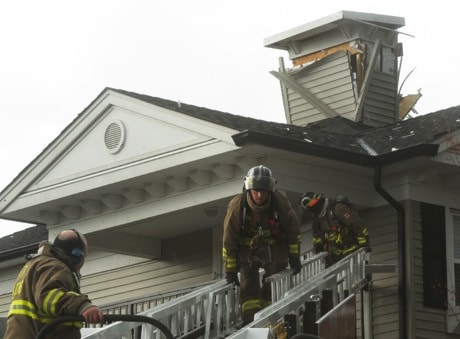When thunder roars, go indoors.
It’s a warning Janie Radom heeded when she heard the first loud bang.
A warm spring day in April turned gloomy within seconds as ominous dark clouds gathered above Maple Ridge and Pitt Meadows.
When rain started spitting, Radom hurried inside with her three-year-old son and 10-month-old daughter.
“It was a beautiful sunny day. You know how you count the thunder strikes to see how far away it is, there was no counting. The flash and the bang came together. I had never heard anything like it in my life,” she says.
Within minutes, there was a second boom. Radom’s husband Darren saw a bright flash and lost sight of his family for a few second.
“He thought we were dead,” she said.
The bright flash was a bolt of lightening that went straight through their town house in Pitt Meadows’ Osprey Village. It hit a chimney on the roof and punched a hole through the ceiling, starting a small fire in the attic. The impact of the strike sucked a blind through an open window.
“We were in a state of shock,” said Radom, who ran back outside with her family after the terrifying strike.
The lightening shorted circuits, fried a telephone line, as well as televisions and computers in neighbouring townhomes. Ten weeks later, the Radoms’ home is still being repaired.
“It looked like there had been a major pillow fight, with lots of insulation over everything and water everywhere,” says Radom.
Although you rarely hear of lightening blasting holes through houses, lightening flashes are common in Canada.
Lightning strikes about 2.34 million times a year, including about once every three seconds during summer.
Environment Canada hoped to dispel many myths about it this week during Lightning Safety Week – including the commonly-held belief that lightening never strikes one place twice.
Each year in Canada, lightning strikes kill up to 10 people, seriously injure 164 others, and ignite some 4,000 forest fires.
The majority of lightning-related fatalities and injuries in Canada occur in Ontario.
A bolt of lightning can travel at speeds of up to 220,000 km/h and reach temperatures approaching 30,000 °C.
The first and most important thing to remember is that if you can hear thunder, you are within striking distance of lightning.
Take shelter immediately, preferably in a house or all-metal automobile (not convertible top). If caught outside, far from a safe shelter, stay away from tall objects, such as trees, poles, wires and fences. Take shelter in a low lying area.
• Learn more about lightening from Environment Canada.
